Daves Old Computers - Other Machines
This section documents machines which do not seem to fit into the other
catagories.
Click any photo to view a large high-resolution image.
 The Intel MCS-80 System Design Kit is a trainer/evaluation board for the
Intel 8080 processor. It contains the 8080 processor, support chips, a small
amount of RAM and a ROM monitor program. This board could be used stand-alone,
or plugged into an Intel "multibus" sustem. This is one of the earliest 8-bit
evaluation boards available. Books.
The Intel MCS-80 System Design Kit is a trainer/evaluation board for the
Intel 8080 processor. It contains the 8080 processor, support chips, a small
amount of RAM and a ROM monitor program. This board could be used stand-alone,
or plugged into an Intel "multibus" sustem. This is one of the earliest 8-bit
evaluation boards available. Books.
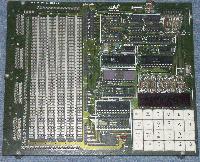 The Intel SDK-85 single board computer is a trainer/evaluation board for the
Intel 8085 processor. It contains the 8085 processor, a keyboard/display and
software monitor, and a large prototyping area so that you can add your own
peripheral circuits. I used these systems during engineering labs when I
attended university. Books.
The Intel SDK-85 single board computer is a trainer/evaluation board for the
Intel 8085 processor. It contains the 8085 processor, a keyboard/display and
software monitor, and a large prototyping area so that you can add your own
peripheral circuits. I used these systems during engineering labs when I
attended university. Books.
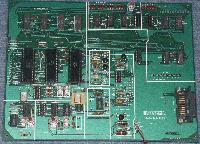 This Intersil 6960 Sampler is an evaluation board for the Intersil 6100
processor, a CMOS implementation of the famous Digital Equipment Corp. PDP-8.
This little board can do what needed whole racks full of equipment only a few
years earlier. Books.
This Intersil 6960 Sampler is an evaluation board for the Intersil 6100
processor, a CMOS implementation of the famous Digital Equipment Corp. PDP-8.
This little board can do what needed whole racks full of equipment only a few
years earlier. Books.
Manual (2.9M PDF)
Sample the 6100 Dec 79 Microcomputing (650k PDF)
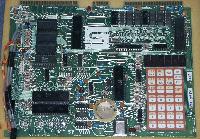 The Synertek SY-VIM-1 is a 6502 based single-board computer that was modeled
after (and competed with) the Commodore KIM-1.
Released in 1978, the name was changed to "SYM-1" later that same year. An
interesting feature of the SYM-1 is that it supported a 32-character video
display with the use of an Oscilloscope as the output device. Here is a
Closeup. The SY-VIM-1 was donated by Don Sawyer.
The Synertek SY-VIM-1 is a 6502 based single-board computer that was modeled
after (and competed with) the Commodore KIM-1.
Released in 1978, the name was changed to "SYM-1" later that same year. An
interesting feature of the SYM-1 is that it supported a 32-character video
display with the use of an Oscilloscope as the output device. Here is a
Closeup. The SY-VIM-1 was donated by Don Sawyer.
 This is a Model 80-153 "6502 Microcomputer" sold by John Bell Engineering in
1980. It consists of the 6502 CPU, 1K or RAM, 2K of ROM and a 6522 "Versatile
Interface Adapter" providing I/O capability. The board on the right is an
Eprom programmer by the same company. Here is a
Closeup. Donated by Don Sawyer.
This is a Model 80-153 "6502 Microcomputer" sold by John Bell Engineering in
1980. It consists of the 6502 CPU, 1K or RAM, 2K of ROM and a 6522 "Versatile
Interface Adapter" providing I/O capability. The board on the right is an
Eprom programmer by the same company. Here is a
Closeup. Donated by Don Sawyer.
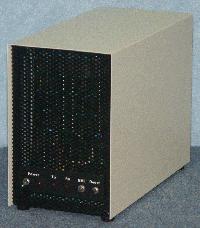 The MicroWAT was developed at the University of Waterloo in Ontario Canada
as a teaching workstation. The 6809 machine is reported to be similar to the
Waterloo 6809 coprocessing board in the SuperPET.
The MicroWAT was developed at the University of Waterloo in Ontario Canada
as a teaching workstation. The 6809 machine is reported to be similar to the
Waterloo 6809 coprocessing board in the SuperPET.
Here is a closeup of the front and back, and
a view inside.
Inside the box is a small cage with various cards,
as well as this key card, which contains a sealed
ROM with a security key needed to operate the system.
Here is a paper on 1980 Waterloo Microcomputer Systems
(450k PDF) which provides some information on the MicroWAT and SuperPET.
If you have documentation or software for this machine, please
contact me. MicroWATs were donated by Markus Wandel
and Ewan Macpherson.
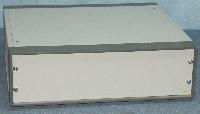 This Northern Telecom 68000 based workstation is an early prototype of their
XMS industrial workstation. The card visible inside
the unit is an 8" floppy diskette controller. It also supports a small hard
drive and runs the UCSD pascal system. The memory SIMs visible near the center
of the board are quite unique. Predating most other SIP memory systems, these
"die on ceramic substrate" devices were developed and manufactured by Nortel
(They were reported to be very unreliable). Here is a view of the
back. Donated by H.C Colford.
This Northern Telecom 68000 based workstation is an early prototype of their
XMS industrial workstation. The card visible inside
the unit is an 8" floppy diskette controller. It also supports a small hard
drive and runs the UCSD pascal system. The memory SIMs visible near the center
of the board are quite unique. Predating most other SIP memory systems, these
"die on ceramic substrate" devices were developed and manufactured by Nortel
(They were reported to be very unreliable). Here is a view of the
back. Donated by H.C Colford.
 The Acorn Atom is a Brittish console machine featuring a 6502 processor, 2K of
RAM (expandable), full sized keyboard and an integer
only BASIC interpreter which could be upgraded to floating point. This is one
of the few machines from the era which did NOT use a variant of Microsoft BASIC.
It is capable of 256x192 pixel graphics which is considerably better than most\
similar machines from the time. View of back.
The Acorn Atom is a Brittish console machine featuring a 6502 processor, 2K of
RAM (expandable), full sized keyboard and an integer
only BASIC interpreter which could be upgraded to floating point. This is one
of the few machines from the era which did NOT use a variant of Microsoft BASIC.
It is capable of 256x192 pixel graphics which is considerably better than most\
similar machines from the time. View of back.
Donated by Richard Parsons.
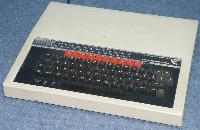 The Acorn BBC succedded the Atom and offered more memory (16, 32 and 64k options),
and more interface options. Shown here is a 32K Model B.
The Acorn BBC succedded the Atom and offered more memory (16, 32 and 64k options),
and more interface options. Shown here is a 32K Model B.Views:
Back,
Bottom,
Inside,
Manuals,
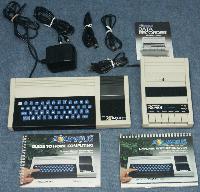 The Acquarius was Mattels short lived foray into personal computers. Cute, but
hopelessly underpowered, the Acquarius was described by Mattels own engineers as
"A 70's machine in the 80's". With less than 2K or RAM, the machine was
practically useless as a computer, however a mini-expander with joysticks
could be added through the cartridge slot, and it enjoyed some popularity as
a basic video game system.
The Acquarius was Mattels short lived foray into personal computers. Cute, but
hopelessly underpowered, the Acquarius was described by Mattels own engineers as
"A 70's machine in the 80's". With less than 2K or RAM, the machine was
practically useless as a computer, however a mini-expander with joysticks
could be added through the cartridge slot, and it enjoyed some popularity as
a basic video game system.
Views:
Close-up,
Back (showing slot),
Bottom of main unit,
Bottom of cassette unit.
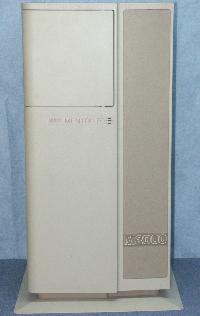 One of the largest machines in my collection, the ADDS Mentor 2000 is a serious
multi-user business machine the size of a small refrigerator. This system runs
the "PICK" operating system. If you ask knowlegable people what "PICK" is, some
will say "Operating System" (OS), and the others will say "Database Management
System" (DBMS). Both are correct, the PICK operating system is designed around
a powerful database file structure. Donated by Willem Boon.
One of the largest machines in my collection, the ADDS Mentor 2000 is a serious
multi-user business machine the size of a small refrigerator. This system runs
the "PICK" operating system. If you ask knowlegable people what "PICK" is, some
will say "Operating System" (OS), and the others will say "Database Management
System" (DBMS). Both are correct, the PICK operating system is designed around
a powerful database file structure. Donated by Willem Boon.
Control Panel - Tape drive, power-switch and interrupt buttons
Back - 16 DB-9 serial ports at lower left side
Open Front - Card cage, hard drive is behind lower part of panel
Open Back - Diagnostic ports (beside fans), main backplane
Information label - And closeup of serial port.
Manuals:
Installation Guide (3.4M PDF),
Software Instroduction (3.8M PDF),
Operating/Procedures (640k PDF).
Other documents:
PICK FAQ (28k PDF),
Guide to PICK (13k TXT).
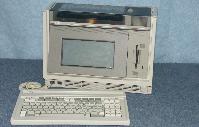 The HP-207 "Integral Personal Computer" is a luggable workstation running
HP-UX. Donated by Kevin Switzer.
The HP-207 "Integral Personal Computer" is a luggable workstation running
HP-UX. Donated by Kevin Switzer.
Views:
Back,
Closed.
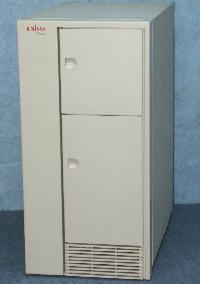 This Unisys A-Series A7-311 is quite an interesting machine. It has both a
486 based EISA system running OS/2 as an I/O system for the Burroughs SCAMP
maingframe processor.
This Unisys A-Series A7-311 is quite an interesting machine. It has both a
486 based EISA system running OS/2 as an I/O system for the Burroughs SCAMP
maingframe processor.
Covers open - see media and controls.
Back - showing I/O connectors
Side cover off - showing mainboard
Mainboard map - showing card/socket positions
Card view - showing Series-A CPU and network cards
Zoomed in - on the SCAMP CPU chip
Looking up - we can see the 486 CPU card
Config label - shows installed cards
 This Yamaha CX5M "Music Computer" is a specialty machine running Microsoft
MSX-DOS and BASIC with a built-in FM synthesizer, Yamaha keyboard interface
and Midi ports. Software on cartridges allows you to compose music, and even
define your own "instruments".
Views:
Main unit,
Sides,
Back.
This Yamaha CX5M "Music Computer" is a specialty machine running Microsoft
MSX-DOS and BASIC with a built-in FM synthesizer, Yamaha keyboard interface
and Midi ports. Software on cartridges allows you to compose music, and even
define your own "instruments".
Views:
Main unit,
Sides,
Back.
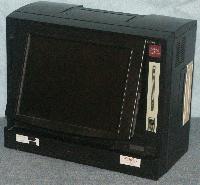 This NekoTech machine is a "portable" Unix workstation based on the
Alpha processor. I do not yet know very much about this machine - please
contact me if you can supply details. Donated by Roland Aubrey.
This NekoTech machine is a "portable" Unix workstation based on the
Alpha processor. I do not yet know very much about this machine - please
contact me if you can supply details. Donated by Roland Aubrey.
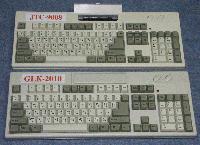 I could find no references to the "JTC-9008", however it appears to be
identical to the "Gold Lepoard King - 2010", which is described as a
"Pirate NES". Apparently a clone of the NES game system. Unlike the NES,
it has a keyboard, and presumably has cartridges which permit programming
or word processing.
I could find no references to the "JTC-9008", however it appears to be
identical to the "Gold Lepoard King - 2010", which is described as a
"Pirate NES". Apparently a clone of the NES game system. Unlike the NES,
it has a keyboard, and presumably has cartridges which permit programming
or word processing.
Although the back clearly states "CPU: 8-bit", when
I first looked inside, I thought that there was
no microprocessor at all - but there is a "board mount" device on the
underside of the board visible to the left. It is a die bonded directly to
the board and covered with "wax" (no IC package).
Back to Old Computers
Copyright 2004-2007 Dave Dunfield.
 The Intel MCS-80 System Design Kit is a trainer/evaluation board for the
Intel 8080 processor. It contains the 8080 processor, support chips, a small
amount of RAM and a ROM monitor program. This board could be used stand-alone,
or plugged into an Intel "multibus" sustem. This is one of the earliest 8-bit
evaluation boards available. Books.
The Intel MCS-80 System Design Kit is a trainer/evaluation board for the
Intel 8080 processor. It contains the 8080 processor, support chips, a small
amount of RAM and a ROM monitor program. This board could be used stand-alone,
or plugged into an Intel "multibus" sustem. This is one of the earliest 8-bit
evaluation boards available. Books.





 This Northern Telecom 68000 based workstation is an early prototype of their
XMS industrial workstation. The card visible inside
the unit is an 8" floppy diskette controller. It also supports a small hard
drive and runs the UCSD pascal system. The memory SIMs visible near the center
of the board are quite unique. Predating most other SIP memory systems, these
"die on ceramic substrate" devices were developed and manufactured by Nortel
(They were reported to be very unreliable). Here is a view of the
back. Donated by H.C Colford.
This Northern Telecom 68000 based workstation is an early prototype of their
XMS industrial workstation. The card visible inside
the unit is an 8" floppy diskette controller. It also supports a small hard
drive and runs the UCSD pascal system. The memory SIMs visible near the center
of the board are quite unique. Predating most other SIP memory systems, these
"die on ceramic substrate" devices were developed and manufactured by Nortel
(They were reported to be very unreliable). Here is a view of the
back. Donated by H.C Colford.
 The Acorn Atom is a Brittish console machine featuring a 6502 processor, 2K of
RAM (expandable), full sized keyboard and an integer
only BASIC interpreter which could be upgraded to floating point. This is one
of the few machines from the era which did NOT use a variant of Microsoft BASIC.
It is capable of 256x192 pixel graphics which is considerably better than most\
similar machines from the time. View of back.
The Acorn Atom is a Brittish console machine featuring a 6502 processor, 2K of
RAM (expandable), full sized keyboard and an integer
only BASIC interpreter which could be upgraded to floating point. This is one
of the few machines from the era which did NOT use a variant of Microsoft BASIC.
It is capable of 256x192 pixel graphics which is considerably better than most\
similar machines from the time. View of back.
 The Acorn BBC succedded the Atom and offered more memory (16, 32 and 64k options),
and more interface options. Shown here is a 32K Model B.
The Acorn BBC succedded the Atom and offered more memory (16, 32 and 64k options),
and more interface options. Shown here is a 32K Model B.





